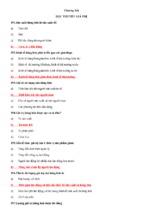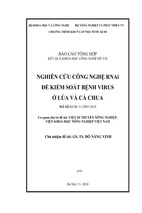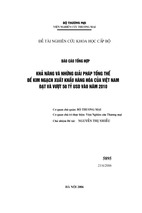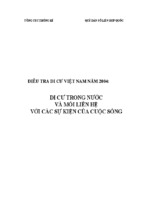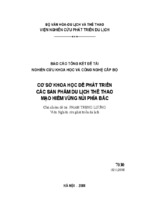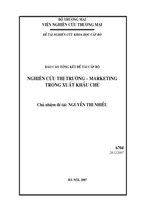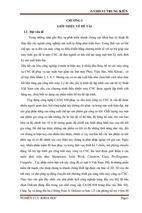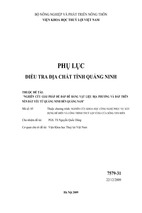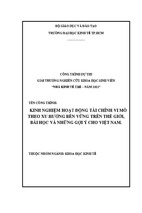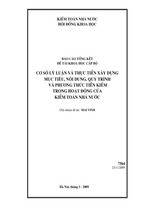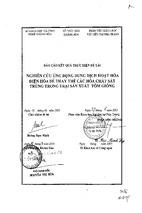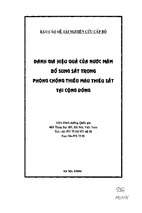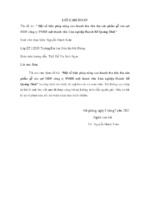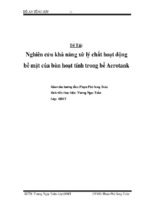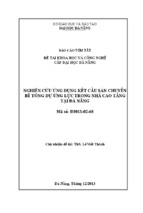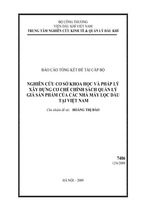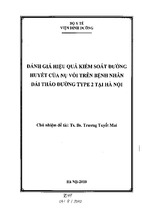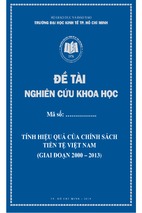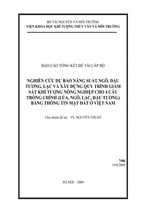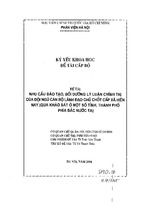THE IMPORTANCES AND IMPACTS OF CORPORATE SOCIAL
RESPONSIBILITY ACTIVITIES OF HANOI CONSTRUCTION &
INVESTMENT COMPANY (HACINCO)
BY
TRUONG VU HOA BINH
E0600053
Supervisor: Dr. Le Van Lien
Graduation Project Submitted to the Department of Business Studies, HELP
University College, in Partial Fulfillment of the Requirements for the Degree of
Bachelor of Business (Accounting) Hons
June 2010
1
Declaration of Originality and Word Count
_________________________________________________________________
DECLARATION
I declare that this graduation project is based on my original work except for
quotations and citation which have been duly acknowledged. I also declare that it
has not been previously or concurrently submitted for any other courses/degrees at
HELP University College or other institutions.
Word Count: 10,015 words.
____________________
Truong Vu Hoa Binh
2
October, 2010
LIST OF ABBREVIATIONS
CSR
Corporate Social Responsibility
Hacinco
Hanoi construction and investment company
HSV
Hacinco Student Village
TBL
Triple Bottom Line
3
TABLE OF CONTENTS
1. INTRODUCTION ............................................................................................... 5
1.1. CSR in the world .......................................................................................... 5
1.2. CSR in Vietnam............................................................................................ 6
1.3. CSR in Hacinco ............................................................................................ 6
1.4. Problem statement ...................................................................................... 11
1.5. Objective of research .................................................................................. 11
1.6. Sphere of research ...................................................................................... 11
1.7. Research methods ....................................................................................... 11
1.8. Structure of the research ............................................................................. 12
2. LITERATURE REVIEW .................................................................................. 13
2.1. The evolution of the CSR concepts ............................................................ 13
2.2. CSR elements ............................................................................................. 15
2.3 Benefits of CSR ........................................................................................... 17
2.4. Ethics and social responsibility in business ............................................... 21
2.5. CSR reporting ............................................................................................. 28
3. RESEARCH METHODOLOGY ...................................................................... 29
3.1. Research Objective ..................................................................................... 29
3.2. Research Methodology ............................................................................... 29
3.3. Data source ................................................................................................. 29
3.4. Research method ........................................................................................ 30
3.5. Research tool .............................................................................................. 30
3.5.1. Questionnaire....................................................................................... 30
3.5.2. Personal interview ............................................................................... 31
3.5.3. Data collection ..................................................................................... 31
3.6. Sampling ..................................................................................................... 31
3.6.1. Sampling population............................................................................ 31
3.6.2. Sample frame ....................................................................................... 31
3.6.3. Sample size .......................................................................................... 31
3.6.4. Sample techniques ............................................................................... 31
3.7. Limitation ................................................................................................... 32
4. FINDING AND ANALYSIS ............................................................................ 33
4.1. Management and staffs ............................................................................... 33
4.1.1. Findings from the questionnaire question ........................................... 33
4.1.2. Findings from the CSR disclosures and reports .................................. 35
4.1.3. Findings from the management interviews ......................................... 36
4.1.4. Overall result from management and staffs‟ responses ....................... 37
4.2. Customer .................................................................................................... 38
4.2.1. Finding from the questionnaire survey ................................................ 38
4.2.2. Overall results from customers‟ responses .......................................... 39
4.3. CSR activities benefit receivers ................................................................. 40
4.3.1. Finding from the questionnaire survey ................................................ 40
4.3.2. Finding from the interview group ....................................................... 40
4.3.3 Overall results from Hacinco social responsibility benefit receivers‟
responses ....................................................................................................... 42
5. CONCLUSION ................................................................................................. 43
4
REFERENCE: ....................................................................................................... 45
1. INTRODUCTION
1.1. CSR in the world
Recently, the social publics have put their interest and raise their concern
to numerous violations of business ethics, environment and harm human health at
serious level. Specifically, in 2008, people in the world were totally shock by the
“putting” contaminated items into the milk products by the Chinese companies,
which caused death to 6 babies, ill and poisonous condition to many people, the
pains suffered by the victims‟ families and the psychological panic to the
unsecured, substandard and unhygienic foods by the social communities. In 2009,
Vedan Vietnam was found guilty as they pumped directly the untreated and
poisonous waste into the Thi Vai River for years, which damaged the living and
working environment of the agriculture workers and the households living around.
In 2010, BP was found irresponsible as its spit oil into the Gulf, which caused
death to a lot of sea creatures and damaged the sea environment.
Now, people in the world care more and more about the responsibility of
the companies: how they do the business, what are the impacts on the
environments and how they solve it, what did they do to contribute to the society.
Corporate Social Responsibility – CSR is not a strange term for the
developed countries in the world. There is a club named “One percent” in the US
which is a group of business entities willing to contribute one percent of their
annual profit to the social activities funds. In France, France Télécom, RATP are
examples of the companies raising funds for the French modern arts.
5
1.2. CSR in Vietnam
Vietnam is just a developing country, most of the business enterprises are
medium size and small size, CSR seem to be a new term then the application and
practice of CSR is not in focus. However, there are some specific companies has
put CSR into their business strategy such as Vinamilk and Dutch Lady launching
social program of “6 million cups of milk for poor children throughout Vietnam“
and “Den dom dom Scholarship”
1.3. CSR in Hacinco
In this paper, we are looking at Hanoi construction and investment
company – Hacinco another example of one of the companies consider the
importance and doing the CSR.
Initially, the company was name as Hanoi Urban Development and
Investment, and then it merged to the Hanoi Construction No2. Hacinco was
established and officially went into operation and doing business since January
1994. The 5 main activities of the company were bidding, doing construction
contracts and Project Investment, testing construction material, trading
construction material, leasing construction equipment and trading and providing
services.
With its resources, Hacinco still keeps diversifying its products and type of
business, focusing on the new projects and new urban centers construction
investment, managing and organizing the residential house and buidings. Hacinco
also expand its joint venture relationships with many domestic and foreign entities
to acquire advanced construction technology invests its building capacity and
applies research of technologies for the manufacturing of advanced building
6
materials. Bidding and doing construction contract is one of its key strength so far
and the company still has it efficiently operated.
For years, Hacinco has been successful in gaining construction bids of key
project in Hanoi such as project of Dong Xuan Market - Bac Qua, Hacinco hotel,
Binh Minh 1 hotel in Hanoi, Nam Trung Yen new urban area, Me Tri Ha new
urban area, renovate the offices of the National Assembly at 35 Ngo Quyen
street…
Seeing the development trend of eco-tourism, sustainable tourism,
humanities, Hacinco is also implementing projects such as the Kinh Bac cultural
tourism at Dam temple, Tu Son, Bac Ninh with area of 70 ha to contribute to
preserving and promoting cultural values.
The company built two blocks B3 and B4 in Cau Dien, Hanoi create
residential housing for low-income people having difficulties in finding houses.
The old dormitory has been a potential threat to the people living around
and also make the bad images.
The dormitory of old, fell saggy potential threat to people living here and
also sleazy, take the urban landscape. Hacinco project to renovate dormitory
Literature target variable neighborhood deteriorated badly for this area become an
urban modern civilization.
Do not bound feet in Hanoi, Hacinco also involved in building many of the
other local hospitals in Dien Bien, traffic control centers in the city of Thai
Nguyen, Binh Minh 2 Hotel in Ha Long…
The dynamics of a flat world Hacinco helped reach more Phonni building
market in Vientiane, Laos and building high-rise housing project in Sofia,
Bulgaria. The company also expanded its business into the field office for rent,
7
houses, business hotels, restaurants and other tourist services, passenger
transport…
Hacinco goal of perfecting and developing all areas of their operations to
take the company into a multi-business company reputation in the market.
Tireless efforts have helped Hacinco success and the 4th consecutive award
quality brand reputation and strong brand award in Vietnam.
Hacinco ranked as one of 10 leading enterprises in the construction field
and are among 300 leading enterprises in Vietnam. Product of student housing
Hacinco award Gold Cup prodtucts and services in 2008 for best 149 enterprises,
entrepreneurs had occurred on 01/03/2009 at the Opera House, Hanoi, the 6th
consecutive award brand reputation and quality awards Brand Vietnam, Brand
Award and the Top 50 Sustainable Green Cup Vietnam Trademark
The award by the Association of Small and Medium Enterprises in
Vietnam, magazines and business integration and East Asian media companies
jointly held to recognize the contributions of businesses, entrepreneurs have
products, optimization services, contributing to change the face of the country‟s
economy.
However, what makes leaders Hacinco is proud of owning a team of
highly qualified professional, including over 500 skilled workers and 30 key
officials over 200 technical staff are university undergraduate and graduate
education in the fields of economics, architecture and construction.
“People are the source of extremely valuable assets of the company so we
are constantly training and developing human resources by providing staff to
study foreign experience and invite foreign experts for guidance, exchange
experiences, “said a leader Hacinco.
8
Besides high quality human resources, Hacinco also actively investing in a
system of construction machinery of modern advances to the most current
Vietnam, especially to meet the construction of tall buildings such as commercial
concrete batching plants, concrete trucks, concrete pump car capable of reaching
44 m high, tower cranes, cage hoists, raised floor, self-propelled cranes and other
construction materials laboratory to help build modern Hacinco qualified
investment execution and construction of projects in Group A, B, C.
With solid experience in the construction and development, today Hacinco
is indeed a powerful company in the members of the Corporation for Investment
and Development of Hanoi, is on the rise a collective position powerful economic
groups in the country.
CSR activities of the Hacinco included providing low-price tourism
services for invalids and their families, providing low-price but high quality
housing for students – Student Village, organizing sports events, cultural and
artistic exchange events for the staffs and the students, raising fund for
scholarship to poor students, …
There is a shortage of housing for colleges and universities students in
Hanoi for years. The number of the colleges and universities in Hanoi having their
own dormitories for students to live in is limited and the rooms supply rarely
meets the students living demand. Most of the school dormitories are old and last
at least 15 years; some of them are one-floor apartments. The quality of the rooms
and the services provided are rather poor; utility supply systems work inefficiently
led to the shortage of water and electric for living.
9
Most of the dormitories in Hanoi are built and owned by the colleges and
universities under the guidelines and control of the Education Ministry. Since the
returns in this kind of investment are rather low and it takes a long time to recover
the initial outflows, so no private units get interested in these investments. So far,
there have only been 2 private dormitory projects in Hanoi; one is Hacinco
Students Village invested by Hacinco and the other is Thang Long dormitory
invested by Thang Long Company. However, according to recent research, over
half of the rooms which initially open for students to live in now have been sold to
the households and private individuals.
Hacinco Students Village is a social-economic project first established in
2000 and aimed to create housing for students who study at the colleges and
universities in Hanoi. This is a joint building with 7 main 7-to-21-floors blocks, in
which consists of comfortable apartments with Internet cable, Television cable,
modern water, light and electric supply systems. In addition, HSV also has
internal roads and green trees areas and provide security services, vehicle parking
and keeping services, etc.
Hacinco also hold an annual Village Festival in October to create a chance
for employees working at Hacinco, for students living at Hacinco to exchange
culture, arts, and sports events. In theses occasions, Hacinco arrange low cost
tours for Vietnamese War Veterans to visit some special spots in Hanoi. The
company partially or fully pays the transports fees, arrange the living place, and
serve meals for all the tourist members. Then Hacinco holds a talk show with the
attendance of the Vietnamese War Veterans and Heroic Vietnamese Mother to
provide staffs and students a chance to listen to the historic stories of the country.
10
1.4. Problem statement
This paper is conduct to find the answer the following question regarding
the CSR activities in Hacnico.
_ What are the attitude and perception of Hacinco and related parties to
Hacinco‟s CSR activities?
_ What are the results and achievement of the Hacinco‟s CSR activities?
1.5. Objective of research
This research is conducted to study the CSR concepts and its
implementation. Furthermore, this is done to help interested parties have a good
view on CSR activities in Vietnam and CSR in Hacinco. Being aware of CSR and
its implementation, directors can enhance the business and management
operations, improve their competitiveness in the marketplace, and thus contribute
to the success of the company.
1.6. Sphere of research
This research was conducted at Hanoi Construction and Investment
Company, Hanoi, Vietnam. And the duration of the research was from 15 July
2010 to 28 September 2010.
1.7. Research methods
Quantitative research was used to gather information on numerical data
and reports, survey and questionnaires was given to related group of people to
obtain information on CSR activities. Other methods will be used are research
questions, data collection, data analysis, population and sampling and variables.
11
1.8. Structure of the research
Chapter 1: Introduction
This chapter presents the preview of the problem of research, some
concepts, nature and purpose of research.
Chapter 2: Conceptual frameworks
This part gives a review of the theoretical framework and defined specific
terms.
Chapter 3: Research Methodology
Chapter 3 includes the research methods, data collection.
Chapter 4: Result analysis
Base on the data and information collected, result will be drawn in this
part.
Chapter 5: Conclusions and recommendations
This chapter gives the conclusions derived from the research. In addition,
it discusses some recommendations and limitations of the research.
12
2. LITERATURE REVIEW
2.1. The evolution of the CSR concepts
What is CSR all about?
Originally, the world witnessed the emergence of the modern definition of
CSR in the 1950s when Howard R. Bowen published the “Social Responsibility
of Businessmen” and in which he is the first man used the phrase “corporate
social responsibility” in 1953. In his book, Howard defined CSR as “It refers to
the obligations of businessmen to pursue those policies, to make those decisions,
or to follow those lines of action which are desirable in terms of the objectives
and values of our society”.
The 1960s saw the wide use of the phrase “corporate social
responsibility”. In 1963, Joseph W McGuire nearly get close to the recent
understanding of CSR as he stated in his book, “Business and Society”: “The idea
of social responsibilities supposes that the corporation has not only economic and
legal obligations but also certain responsibilities to society which extend beyond
these obligations”.
Through the 1970s and 1980s, the construction of the concepts has grown
impressively as there are more definitions, and alternative themes like Social
corporate performance, stakeholder theory and business ethics theory started to
mature. In 1971, the Committee for Economic Development became the first men
presented the model of CSR in its publication, the Social Responsibilities of
Business Corporations. The model consists of three circles, the inner circle
presents the core aim of making profit of organization, the intermediate circle
presents the responsibilities the organizations must take in case of there is a
13
conflict between its economic interests and the social interests; the outer circle
presents the responsibilities that the organizations must pursue to improve the
environment, the social living standards and other issues. In addition, in 1989, the
first social report of the world was published by an ice-cream company, Ben &
Jerry‟s.
From the 1980s up to now, the definitional construct for CSR has still been
developing with many other concepts. For example,
“A concept whereby companies integrate social and environmental
concerns in their business operations and in their interaction with their
stakeholders on a voluntary basis.”
The European Commission
“Corporations have a social responsibility and moral duty to use the power
of markets to make globalization a positive force for all.”
United Nations
“Companies are realizing that it is in their business interest to „do the right
thing‟ everywhere they operate. Global firms are keenly aware that their longterm investment goals can only be achieved within a stable, healthy and free of
social and financial environment. But companies alone cannot solve the
challenges associated with social responsibility. They must work in cooperation
with governments, civil society groups, development institutions, and citizens.”
World Bank
However, there is no single concept can widely be used and commonly
accepted. In general, Corporate Social Responsibility (CSR) is about how the
organizations manage their operation process in order to meet the original
operating objective as well as to act ethically and contribute the welfare to the
14
whole social community. There is no exception among the organizations in doing
the CSR: not only the non-profit organizations and the non-government
organization conducting the charity works but also the business entities doing
their business while still behave ethically to the environment. It seems to be a
tough job for the business entities as they are still moving forward to meet the
economic figures target whilst managing and redirecting their behaviors on how
to fit the ethical standards and improving the life quality of employees and their
families, and the local community.
2.2. CSR elements
1. Responsibilities to the marketplaces and the consumers
When a company doing business, it introduces its goods and services to
the marketplaces and delivers them to the consumers. Consumers normally see the
companies how good they are by consider their quality of goods and services. In
one hand, if the goods and services satisfy with the consumer‟s requirement, they
would also satisfy with the company, get used to the company image and support
them by choosing their products when they have options while doing shopping.
On the other hand, if the consumers dissatisfy with the goods and services they
buy, they would set a defensive thought against them and view the company in a
bad image, some of them stop to buy the company‟s goods and products, some of
them go to tell the others about the bad things they suffer and convince them not
to support the company any more. So, in order not to loose the consumers, the
company should take responsibilities to the goods and products they offer by
15
setting a high standard for the manufacturing process and taking good care on the
consumers by providing good after-purchasing services.
2. Responsibilities to the environment
Many companies and firms in the world and also in Vietnam normally just
focus on profit maximization and set the cost at low level. One of the costs that
burden the company is the environmental costs. Environmental costs include cost
of processing the waste and emission, cost of recovery the state of the polluted
environment. In order to maximize the profit, some companies cut down the costs
for waste processing process. They believe that the waste and emission come from
their manufactures are too small and not much enough to damage or cause
pollution to the environment so they ignore the processing process. Some others
think that the responsibilities to the environment belong to the local agencies and
the government and they want the government to take the environmental costs.
However, according to recent scandal in some specific places in the world, some
companies that do not have waste processing process or spend less money for this
part finally have to burden the cost of recovery the state of the polluted
environment. This not only costs the company much more than the first cost but
also cause a bad image of the company. For instance, in Vietnam, many
consumers reject to buy the Vedan products as they are aware that the Vedan
company has cause pollution to the Thi Vai river and still do not want to
compensate for what they have done.
3. Responsibilities to the employees
16
Employees could also be the company‟s consumer so firstly they should
be treated as consumers like having rights to use good quality products and
services and accessing to the after-purchasing services.
Employees are able to be viewed as the ambassadors to the company.
They are the best people to have a good understanding about the company‟s
culture, the company‟s vision, the company‟s orientation, the company‟s goods
and services and the company‟s behaviors to the customers. So in order to be
well-advertised by these ambassadors, the company act to be a good business
entity, and then they should have a good treatment policies to their staffs.
4. Responsibilities to the social community
It is not only the staffs for which the company builds good treatment
policies, the company should also spend some of their profits to help social
community by charity works, poor or disable foundation . This is not only for
public relation campaign but also for the culture of the company that they should
be. As the company takes good care of the social community, the company would
gain trust from them, and people would view the company as a good image. Some
of them could be potential customers or client of the company in the future. In
addition, as the company carries out the social charity works, these would build a
good spirit among the staffs in the company and create a good corporate culture,
then every employee feel happy with the company, feel pleased with what the
company does and then they would devote their best effort to their jobs, contribute
more and more to the success of the company.
2.3 Benefits of CSR
17
There is a Chinese proverb says that: “Give a man a fish, feed him for a
day. Teach a man to fish, feed him for a lifetime.” In short-term period, benefits
that CSR can bring to us are the contracts and purchase orders from the companies
that require CSR standards. However, the cost of applying CSR will be able to
affect the business operation result of the company. Leaders who have ability of
foreseeing the future will set the goals of operation that not simply limited by
profits. Their success standards start from the impacts that they create for the
social demands. These businessmen are seeking for solutions to change the
society into a better way and vice versa, their business entities are likely to have
better conditions for more sustainable development.
The main long-term period benefits of CSR for the internal business
entities are improving working relationship at workplace, reducing the working
accidents, decreasing the turnover rate, increasing the labor productivity. In
addition, CSR also help enhancing the prestige of the business in relationship with
the clients and partners, creating competitive advantages in calling for investment,
especially the foreign investment.
How to manage a business entity that has responsibilities to the society?
In order to be success, the term social responsibilities must be built from
the base of the business goals
It‟s much more easier to establish the culture of social responsibilities
from the beginning rather than to change the company culture in the future
The success SCR program should base on the establishment of trusts and
supports from the customers and social community, the staffs, the providers and
distributors, the investors and banks, and finally the government agencies.
18
CSR should be initially from the leaders. If the managers do not believe in
the importance of the CSR, if they do not take part in or support the CSR
activities, if they do not behave well at works as well as at their personal life, CSR
will not work.
CSR need to be applied in every activity of the companies and all the
related parties.
Business entities need to have good understanding about the CSR.
However, the company can not exist if it bases only on CSR. For a longterm development, the company should make profits. Profits and CSR can be
together and even in long term period, managing the business entities to have
responsibilities to the society normally lead to sustainable development and higher
profits.
The business entity should have a good understanding about CSR:
CSR is not a marketing trick to advertise for the business‟s images
CSR is not simply a charity work
CSR is not able to replace good-quality products and services of the
business entities
CSR is not able to replace the profits
Some people are afraid that there are more difficulties as applying CSR in
small and medium-sized businesses rather than large businesses since the
resources of small and medium-sized are too scare and can not meet the demands
of expensive CSR programs. That point of view is not definitely right; a small and
newly established business is not able to be successful and sustainably developed
if it do not practice the social responsibilities activities at the beginning.
19
In addition, CSR practices are not always and necessarily expensive. CSR
is important as the process of implementing it but not the certificate paper. It is
not meaningful if the business just cares about the paper but not the real practicing
process. Business entities would be able to be successful in practicing CSR if
there is guarantee and support from the board of managers, and have a good
understanding about the importance and benefits of CSR in the long-term period
and CSR would be part of the organizational culture.
Some barriers and opportunities when doing CSR in Vietnamese
organizations
According to World Bank research on implementing CSR in textile and
garment industry in Vietnam in 2002, there are some barriers and disadvantages:
There are major differences in the perception and understanding of CSR
within and between enterprises in Vietnam.
A company apply a multiple set of rules of behavior are not effective
Lack of financial resources and technical capacity to implement CSR
standards, especially for small and medium-sized enterprises
The difference between the Labor Code and the Code of Conduct for
customer orders cause confusion for businesses, for example, in the matter of
overtime hours or union activities.
Lack of transparency in the application of CSR in fact hampering potential
market benefits for the enterprises
Inconsistency in the regulations of the State makes the application of the
code of conduct does not have desire effects, such as salary, benefits and
conditions of employment.
20
- Xem thêm -

